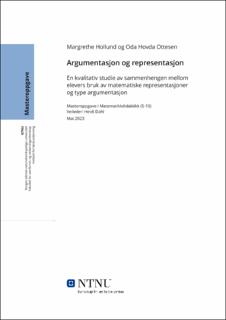| dc.contributor.advisor | Dahl, Heidi | |
| dc.contributor.author | Hollund, Margrethe | |
| dc.contributor.author | Ottesen, Oda Hovda | |
| dc.date.accessioned | 2023-07-15T17:23:30Z | |
| dc.date.available | 2023-07-15T17:23:30Z | |
| dc.date.issued | 2023 | |
| dc.identifier | no.ntnu:inspera:139328562:34743720 | |
| dc.identifier.uri | https://hdl.handle.net/11250/3079523 | |
| dc.description.abstract | I denne studien undersøkes elevers bruk av matematiske representasjoner når de skal argumentere for gyldigheten til to matematiske påstander. Formålet med studien var å se om det fantes en sammenheng mellom måten elevene tok i bruk representasjonen, og hvordan de argumenterte for en påstand. I dette arbeidet ønsket vi å studere om representasjonen fungerte som et nyttig verktøy i elevenes argumentasjon. Med denne studien ønsket vi å bidra til forskningsfeltet med å se på hva som kjennetegner elevenes argumentasjon, samt hva som kan være viktige faktorer i arbeidet deres. Studiens forskningsspørsmål er: Hvilke sammenhenger kan identifiseres mellom elevenes bruk av matematiske representasjoner og elevenes type argumentasjon?
Studien er basert på kvalitative metoder gjennom observasjon av en undervisningsøkt på 7. trinn, hvor elevene skulle argumentere for gyldigheten til to matematiske påstander. Vi observerte 14 elever, som var fordelt på fire grupper. Datamaterialet ble samlet inn av forskningsprosjektet ProPrimEd. Materialet består av transkripsjoner fra tre av gruppenes arbeid//diskusjoner, transkripsjoner av oppstart og oppsummering av timen, samt elevenes skriftlige besvarelser. Analysen av datamaterialet var deduktiv, og elevens argumentasjon ble kategorisert etter G. Stylianides (2008) sine argumentasjonstyper. De matematiske representasjonene ble sortert ut fra Duval (2006) sitt semiotiske representasjonssystem. I analysen ble elevenes besvarelser og argumentasjon kategorisert med utgangspunkt i representasjonstypene elevene brukte.
Resultatene fra studien viser at det kan finnes en sammenheng mellom hvordan elevene tar i bruk representasjoner, og hvilket argument de presenterer. Studien viser at de fleste elevene argumenterer empirisk for å bekrefte påstandens gyldighet, men at aktiv bruk av representasjonene kan øke potensialet i argumentene. Vi fant også at elever som tok utgangspunkt i strukturen i påstandene da de utformet representasjoner, kom nærmere et generisk eksempel enn elever som ikke gjorde dette. I tillegg er et viktig funn i studien at elever med støtte og veiledning fra lærer, og gjennom diskusjon med hverandre, kom frem til et gyldig bevis. | |
| dc.description.abstract | This study examines how students use mathematical representations when they argue for the validity of two mathematical statements. The purpose of the study was to see if there was a connection between the way students used the representations, and how they argued for å claim. We wanted to examine whether the representations functioned as a useful tool in the students' argumentation. With this study, we wanted to contribute to the research field by looking at what characterizes the students' argumentation, as well as what may be important factors in their work. The research question of this study is: What connections can be identified between the students' use of mathematical representations and the students' type of argumentation?
The study is based on qualitative methods through observation of a teaching session in the 7th grade, where the students were supposed to argue for the validity of two mathematical statements. We observed 14 students who were divided into four groups. The data material was collected by the research project ProPrimEd and consists of transcriptions from three of the groups' discussions, transcriptions from the joint start and end of the lesson, as well as the students' written answers. The analysis of the data material was deductive, and the student's argumentation was categorized according to G. Stylianides' (2008) argumentation types. The mathematical representations were sorted according to Duval's (2006) semiotic representation system. In the analysis, the students' answers and arguments were categorized based on the types of representation they used.
The results of the study show that there can be a connection between how students use representations and the arguments they present. The study shows that most students argue empirically to confirm the validity of the claim, but that active use of the representations can increase the potential of the arguments. In addition, we found that students who based the representation on the structure of the claim, came closer to a generic example, than students who did not take the structure into consideration. An important finding in this study is that discussions with other students, and support and guidance from a teacher helped some students produce a valid proof. | |
| dc.language | nob | |
| dc.publisher | NTNU | |
| dc.title | Argumentasjon og representasjon | |
| dc.type | Master thesis | |
